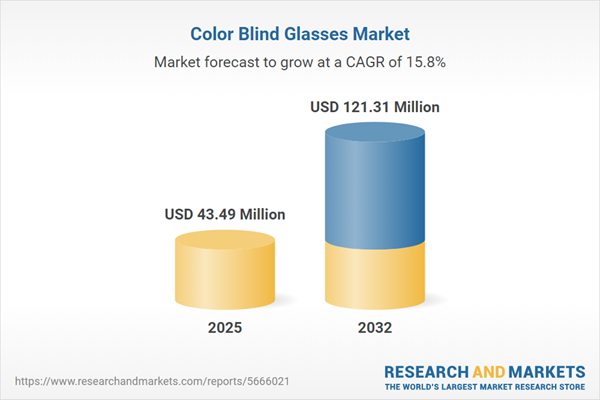Speak directly to the analyst to clarify any post sales queries you may have.
The color blind glasses market is rapidly evolving as organizations adapt to changing technologies, growing user diversity, and shifting distribution channels. To compete effectively, senior decision-makers must leverage actionable, sector-specific research that addresses advanced product integration and the increasing importance of visual accessibility.
Market Snapshot: Growth and Transformation in the Color Blind Glasses Market
The color blind glasses market is experiencing accelerated growth, demonstrated by significant expansion in market size and a robust compound annual growth rate projected for 2024 to 2032. This momentum arises from rising global awareness of color vision deficiencies and increased integration of sophisticated visualization technologies across healthcare, education, and commercial sectors. As organizations respond to heightened expectations for visual accessibility, they are prioritizing effective strategies for color correction deployment. The evolving landscape requires organizations to refine both product offerings and resource allocation to support a diverse user base and new distribution models.
Scope & Segmentation: Detailed Analysis of the Color Blind Glasses Sector
This report delivers targeted color blind glasses market analysis to inform senior leadership. Clearly outlined segments provide actionable insights for those shaping technology adoption, distribution, and competitive strategy. Understanding the interplay between channel diversity and technological progress allows organizations to align more closely with both end-user demands and regulatory standards.
- Technology Type: Digital color correction electronic glasses offer advanced color detection, while passive optical filters allow immediate improvement in color differentiation. Innovations in photonic crystal lenses are extending usability and broadening the range of target users in both clinical and daily contexts.
- Distribution Channels: Product reach now encompasses brick-and-mortar retail, optometry centers, pharmacies, emerging e-commerce platforms, and tele-optometry services. This omni-channel landscape creates robust accessibility, enabling efficient service delivery across urban and rural regions.
- Geographic Coverage: The Americas, Europe, Middle East & Africa, and Asia-Pacific present distinctive operational, regulatory, and market entry conditions. Companies are optimizing regional strategies to navigate diverse healthcare environments and compliance requirements while pursuing new partnership opportunities.
- Key Companies Covered: Leading organizations such as EnChroma, Pilestone Technology, O2Amp, Chromagen, Chromatic Vision Solutions, ColorCorrectionSystem, VINO Optics, See Eyewear, IrisVision, and X-Chrom are driving innovation. Their focus covers both hardware devices and integrated digital solutions, supporting diverse deployment strategies and tailored market positioning.
Key Takeaways for Senior Decision-Makers
- Emerging lens technologies combined with advanced digital integration are increasing the practical value and lifespan of color blind glasses, expanding their market reach to new user groups in different sectors.
- Collaborative relationships between technology providers and educational institutions are accelerating market adoption by streamlining technology transfer and improving visibility among professional and academic buyers.
- Blended distribution strategies, incorporating both in-person and digital channels, are enabling flexible responses to changing consumer preferences and improving engagement with clients in various settings.
- Building durable partnerships with healthcare professionals reinforces organizational credibility and supports procurement processes in institutional and enterprise markets.
- Diversification across distribution channels is protecting organizations from regulatory and operational disruptions, ensuring stable operations as the market landscape evolves.
- Ongoing regulatory collaboration and joint initiatives with academic stakeholders are enhancing trust and transparency, supporting consistent purchasing decisions, especially in complex institutional contexts.
Tariff Impact: Navigating Cost Pressures and Supply Dynamics
Persistent U.S. tariffs on raw materials and electronic components are reshaping input costs for color blind glasses manufacturers. Organizations are mitigating these impacts by expanding their supplier networks, negotiating reliable long-term contracts, and redesigning products to boost efficiency. These actions support cost stability and operational resilience, while adaptive pricing and distribution strategies help organizations preserve customer relationships and maintain profit margins amidst fluctuations in global trade conditions.
Methodology & Data Sources
Findings are drawn from direct interviews with ophthalmic experts, feedback from key industry stakeholders, targeted user experience assessments, literature analysis, patent monitoring, and systematic regulatory review. This comprehensive approach ensures recommendations meet the demands of leadership navigating a complex and dynamic sector.
Why This Report Matters
- Puts organizations ahead of emerging technology and policy shifts, allowing decision-makers to anticipate risk and capture opportunities for growth in color vision correction solutions.
- Aligns procurement and operational processes to global best practices, supporting compliance and efficient deployment within a broad and competitive market context.
- Strengthens investment confidence by providing validated, actionable market intelligence for sustainable operational and strategic improvement.
Conclusion
Strategic investment in technology, adaptive distribution, and resilient cost management will enable organizations in the color blind glasses market to achieve sustainable progress and support evolving user needs throughout industry transformation.
Additional Product Information:
- Purchase of this report includes 1 year online access with quarterly updates.
- This report can be updated on request. Please contact our Customer Experience team using the Ask a Question widget on our website.
Table of Contents
3. Executive Summary
4. Market Overview
7. Cumulative Impact of Artificial Intelligence 2025
Companies Mentioned
The companies profiled in this Color Blind Glasses market report include:- EnChroma, Inc.
- Pilestone Technology Co., Ltd.
- O2Amp, LLC
- Chromagen Limited
- Chromatic Vision Solutions, LLC
- ColorCorrectionSystem, LLC
- VINO Optics Limited
- See Eyewear Limited
- IrisVision, Inc.
- X-Chrom, LLC
Table Information
| Report Attribute | Details |
|---|---|
| No. of Pages | 195 |
| Published | November 2025 |
| Forecast Period | 2025 - 2032 |
| Estimated Market Value ( USD | $ 43.49 Million |
| Forecasted Market Value ( USD | $ 121.31 Million |
| Compound Annual Growth Rate | 15.8% |
| Regions Covered | Global |
| No. of Companies Mentioned | 11 |









